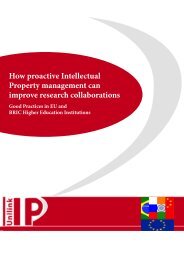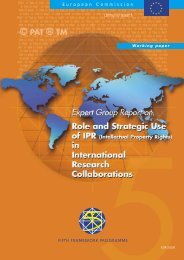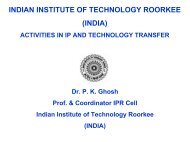emembered that it is likely that a range <strong>of</strong> IPRs will be required by the <strong>in</strong>dustrial party, <strong>in</strong>clud<strong>in</strong>gpatent rights, materials and Know-how.3.4.2. Scope <strong>of</strong> the LicenseThis is the key aspect <strong>of</strong> any License Agreement. Decisions need to be made about the scope <strong>of</strong> therights to be granted. Are they to be exclusive? Non-exclusive? A comb<strong>in</strong>ation? Exclusivity can begranted to the whole IPR portfolio, or simply to certa<strong>in</strong> parts e.g. Patent Rights, while other aspectsrema<strong>in</strong> non-exclusively licensed such as know how and methodology. Exclusivity can also be def<strong>in</strong>edby different fields <strong>of</strong> use e.g. for use <strong>in</strong> the chemical <strong>in</strong>dustry while the same technology could beexclusively used <strong>in</strong> the electronics <strong>in</strong>dustry where the two fields <strong>of</strong> use are not competitive.Furthermore, territorial exclusivity is also a potential model e.g. the North American market could belicensed to a different company from that which operates <strong>in</strong> Europe.Depend<strong>in</strong>g on the nature <strong>of</strong> the technology, it may be attractive for <strong>in</strong>dustry to acquire non-exclusiverights. This is <strong>of</strong>ten the case where either the technology is at a very early stage such that the endproduct or process, which would generate commercial <strong>in</strong>come, would be the subject <strong>of</strong> <strong>in</strong>dependentIntellectual Property Rights developed and owned downstream by the company. Alternatively wherethe technology is <strong>of</strong> a truly generic <strong>in</strong>terest where there may be other alternatives available such asalternative s<strong>of</strong>tware models, any non-exclusive user license may be attractive.3.4.3. Sub Licens<strong>in</strong>gIn determ<strong>in</strong><strong>in</strong>g the scope <strong>of</strong> the license rights to be granted, as well as the direct rights by a companyto commercially develop, market, sell, utilise etc., the access by third parties to technology ought toalso be considered. Depend<strong>in</strong>g on the nature <strong>of</strong> the technology be<strong>in</strong>g licensed, it may be necessary forthe ma<strong>in</strong> company licensee to be able to pass on i.e. sub license some <strong>of</strong> the rights to third parties e.g.customers or partners. Alternatively, the PRO may not wish the licensee company to sub license allrights to third parties <strong>in</strong> place <strong>of</strong> a direct license be<strong>in</strong>g granted to a third party by the PRO. Thesematters ought to be clearly agreed upon by the PRO and company.3.4.4. Performance ObligationsIn grant<strong>in</strong>g licences to technology, it is important to ensure that the company assumes obligations todevelop and utilise the technology until either it reaches the market or otherwise fails to fulfil itscommercial promise. It is important for the PRO to see that the technology is not locked away, s<strong>of</strong>ailure by a licensee to fulfil this obligation should lead to a reduction or loss <strong>of</strong> rights.3.4.5. Reward MechanismsWhile grant<strong>in</strong>g licenses to allow technology to be developed and to commercialise can be seen as aspeculative process because <strong>of</strong> the nature <strong>of</strong> PRO technology is usually at such an early stage, theparties must also be rem<strong>in</strong>ded that the technology may <strong>in</strong> fact turn out to be highly successful. Abalance needs to be found to reflect the relative contribution <strong>of</strong> the PRO and the company to thecommercial success. While the early stage development will have been done by the PRO, there maybe an early stage upfront payment for the PRO <strong>in</strong> return for grant<strong>in</strong>g a license. However, other factorswill determ<strong>in</strong>e the ultimate “price” <strong>of</strong> any license to be entered <strong>in</strong>to. The stage <strong>of</strong> development <strong>of</strong> thetechnology, the nature <strong>of</strong> the technology and the scope <strong>of</strong> the rights be<strong>in</strong>g granted to the <strong>in</strong>dustrialpartner will all determ<strong>in</strong>e the level <strong>of</strong> reward to the PRO. It is normal for there to be some element <strong>of</strong>an upfront fee (unless the <strong>in</strong>dustrial partner has been collaborat<strong>in</strong>g to sponsor the early stage <strong>research</strong>)however, other f<strong>in</strong>ancial aspects <strong>of</strong> the license usually l<strong>in</strong>k the success <strong>of</strong> the technology to anentitlement to revenue shar<strong>in</strong>g. It is common for a series <strong>of</strong> milestones l<strong>in</strong>ked to the development <strong>of</strong>the technology to perhaps trigger further payments to the PRO. Ultimately, if there is commercialsuccess then a royalty payment l<strong>in</strong>ked to the level <strong>of</strong> commercial success is usually acceptable to allparties. In this way, where the <strong>in</strong>dustrial partner is bear<strong>in</strong>g the risk <strong>of</strong> all the downstream development,28
it is not usually required to pay additional licens<strong>in</strong>g fees unless the technology turns out to besuccessful.3.4.6. Patent <strong>Management</strong>If the subject matter <strong>of</strong> the IPR <strong>in</strong>cludes patent portfolio then it is important for the parties to agreeexactly where responsibilities will lie. Issues <strong>in</strong>clude decision mak<strong>in</strong>g about the prosecution towardsgrant <strong>of</strong> the portfolio, allocation <strong>of</strong> responsibility <strong>of</strong> meet<strong>in</strong>g the costs <strong>of</strong> such prosecution. Inaddition, responsibility for pursu<strong>in</strong>g <strong>in</strong>fr<strong>in</strong>gers or be<strong>in</strong>g entitled to defend <strong>in</strong>fr<strong>in</strong>gement allegationsneeds to be agreed.3.4.7. Term<strong>in</strong>ation <strong>of</strong> LicenseObviously to be comfortable that the license rights held by the company are sufficiently robust tojustify substantial development by the company <strong>in</strong> the technology, there must be very limited groundsfor the license to be term<strong>in</strong>ated. There is likely to be a relationship between any performanceobligations, which the company has undertaken with regard to actively develop<strong>in</strong>g the technology.The PRO should only be entitled to term<strong>in</strong>ate any license if there has been a material breach <strong>of</strong> theprovisions <strong>of</strong> the agreement, <strong>in</strong>clud<strong>in</strong>g where the expectation that the company proactively developstechnology has not been met. Careful discussion between the parties about the different triggers forany such term<strong>in</strong>ation needs to be set out. L<strong>in</strong>ked to this issue may be an option to identify an externalarbiter whose op<strong>in</strong>ion about the compliance by either party with the terms <strong>of</strong> the license may behelpful.3.4.8. Indemnity/LiabilityWhile the company will require some satisfaction that the PRO is entitled to enter <strong>in</strong>to a LicenseAgreement, there may be warranties requested about ownership <strong>of</strong> the relevant IPR etc. However,there may be a downstream exposure to the PRO to claims by third parties who may have suffered lossas a result <strong>of</strong> us<strong>in</strong>g the technology made available by the licensee company. It is usual for there to beat least product <strong>in</strong>demnity <strong>of</strong>fered by the company to the PRO. However, downstream responsibilitiesto third parties need to be agreed carefully between parties. Different legal jurisdictions have differentexpectations <strong>of</strong> the reta<strong>in</strong>ed responsibility <strong>of</strong> any owner <strong>of</strong> IPR. For example <strong>in</strong> the United Statesthere can be reach through by claims to the patent owner notwithstand<strong>in</strong>g the fact that the license maypass on responsibility to a licensee company.29







